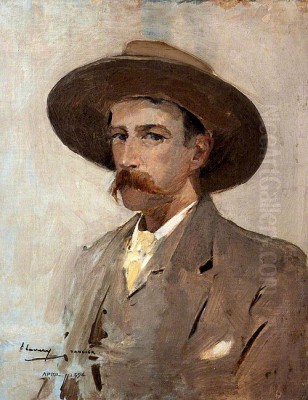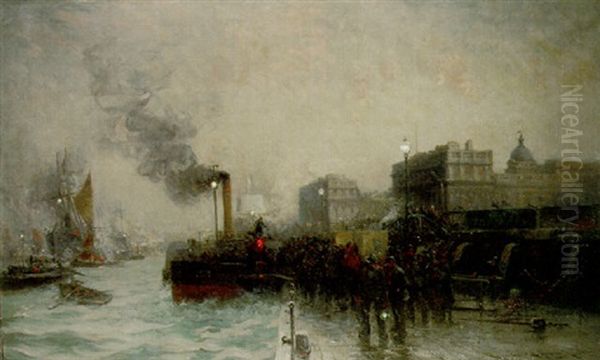
Edmund Aubrey Hunt (1855–1922) stands as a notable American painter, primarily celebrated for his evocative Orientalist scenes and luminous depictions of Venice. Born in Weymouth, Massachusetts, Hunt emerged during a period when American artists were increasingly looking beyond their national borders for training, inspiration, and subject matter. His career reflects a dedication to capturing the exotic allure of distant lands, rendered with a keen eye for detail, color, and atmosphere, placing him among a fascinating group of Western artists who engaged with the cultures of North Africa and the Near East.
Early Life and Artistic Formation
Hunt's artistic inclinations led him to seek formal training in Europe, a common path for ambitious American artists of his generation. He traveled to Paris, the undisputed center of the art world in the 19th century, to study at the prestigious École des Beaux-Arts. There, he became a pupil of Jean-Léon Gérôme, one of the most prominent academic painters and a leading figure in the Orientalist movement. Gérôme's meticulous technique, his emphasis on historical and ethnographic accuracy (albeit often romanticized), and his dramatic compositions profoundly influenced a generation of artists, including Hunt.
Under Gérôme's tutelage, Hunt would have honed his skills in draughtsmanship and oil painting, absorbing the academic tradition while also being exposed to the burgeoning interest in "exotic" subjects. This period in Paris was crucial, not only for technical development but also for shaping his thematic interests. The city itself was a hub for artists returning with sketches and artifacts from their travels, further fueling the Western fascination with the "Orient." Other American artists in Paris at the time, or shortly thereafter, included figures like John Singer Sargent, Mary Cassatt, and Frederick Arthur Bridgman, each forging their own unique paths but contributing to a vibrant expatriate art scene.
The Allure of the Orient and Mediterranean Light

Inspired by his master and the prevailing artistic currents, Edmund Aubrey Hunt embarked on extensive travels, which became the cornerstone of his artistic output. His journeys took him to Spain, particularly Andalusia with its rich Moorish heritage, and significantly to North Africa, with Morocco and Egypt providing a wealth of subjects. Tangier, with its bustling markets, ancient gateways, and vibrant street life, became a recurring motif in his work. He also spent considerable time in Venice, captivated by its unique interplay of water, architecture, and light, a subject that had enchanted artists for centuries, from Canaletto to J.M.W. Turner.
Hunt's approach to these locales was characteristic of many Orientalist painters. He was drawn to the perceived exoticism, the vibrant colors of textiles and ceramics, the play of intense sunlight and deep shadow on ancient architecture, and the daily customs of the people. His paintings often depict market scenes, quiet courtyards, majestic city gates, and figures in traditional attire, seeking to convey both the grandeur and the intimate moments of these cultures. While the Orientalist genre has since been critiqued for its potential to perpetuate stereotypes, artists like Hunt were often genuinely captivated by the visual richness and perceived timelessness of the lands they depicted.
Artistic Style and Thematic Concerns
Edmund Aubrey Hunt's style is characterized by a skilled handling of oil paint, a bright and often sun-drenched palette, and a strong sense of composition. His works demonstrate a fine attention to detail, particularly in rendering architectural elements, textures of fabrics, and the varied activities of street life. He was adept at capturing the quality of light, whether it was the brilliant Mediterranean sun casting sharp shadows in a Tangier street or the softer, diffused light reflecting off Venetian canals.
His paintings, such as "A Street in Tangier," "The Orange Seller, Tangier," or "Gateway of the Kasbah, Tangier," showcase his ability to create lively, atmospheric scenes. Figures are often integrated naturally into their surroundings, engaged in conversation, trade, or quiet contemplation. These works aimed to transport the viewer, offering a glimpse into worlds that seemed far removed from the industrializing West. His Venetian scenes, like "A Sunlit Canal, Venice," similarly focus on light and atmosphere, capturing the shimmering reflections and the timeless beauty of the city.
Hunt's work can be seen in dialogue with other American Orientalists like Frederick Arthur Bridgman and Edwin Lord Weeks, who also studied with Gérôme and extensively depicted North African and Middle Eastern subjects. European counterparts such as Ludwig Deutsch and Rudolf Ernst, both Austrian painters working in Paris, produced highly detailed and popular Orientalist scenes. Hunt's contribution lies in his particular sensitivity to light and his ability to imbue his scenes with a sense of lived reality, even within the romanticized framework of Orientalism.
Notable Works and Their Characteristics
Several paintings stand out as representative of Edmund Aubrey Hunt's oeuvre, illustrating his thematic preoccupations and stylistic strengths.
"The Gateway, Tangier" is a classic example of his Moroccan subjects. It typically features an imposing architectural archway, a common motif in Orientalist art symbolizing passage into another world. Hunt would meticulously render the textures of the stone and tilework, often contrasting the bright sunlight outside the gate with the cooler shadows within. Figures in traditional djellabas and kaftans populate the scene, adding to the sense of authenticity and local color. The composition often draws the viewer's eye through the gateway into the bustling city beyond.
"An Arab Market" (or similar titles depicting souks) showcases Hunt's skill in handling complex, multi-figure compositions. These paintings are alive with activity: merchants displaying their wares, customers haggling, animals intermingling with the crowd. Hunt would pay close attention to the diverse goods on offer – textiles, pottery, spices – using them as opportunities to introduce vibrant splashes of color. The interplay of light filtering through awnings or openings creates a dynamic pattern of light and shadow, enhancing the scene's vivacity.
"A Venetian Canal Scene" demonstrates his versatility and his appreciation for different kinds of light and atmosphere. In these works, the focus shifts to the unique urban landscape of Venice. Gondolas glide along shimmering canals, flanked by weathered palazzi. Hunt masterfully captures the reflections on the water's surface and the way sunlight illuminates the colorful facades of the buildings. These paintings often evoke a sense of tranquility and romantic charm, akin to the works of Venetian specialists like Federico del Campo or earlier masters such as Francesco Guardi.
While specific titles like "the last boat from greenwich" or "on a mountainpath" are less prominently associated with his core Orientalist and Venetian body of work in major art historical records, his primary fame rests on his depictions of North African and Venetian life. It's important to note that artists often produce a range of subjects, and regional auction records or private collections might contain works outside an artist's most famous genre. However, his enduring legacy is tied to his Orientalist contributions.
Hunt in the Context of His Contemporaries
Edmund Aubrey Hunt operated within a rich and diverse art world. His teacher, Jean-Léon Gérôme, was a towering figure whose influence extended to many international students. Among Hunt's American contemporaries who also embraced Orientalist themes, Frederick Arthur Bridgman is perhaps the most comparable, having also studied with Gérôme and achieved considerable success with his detailed scenes of Algerian and Egyptian life. Edwin Lord Weeks was another prominent American Orientalist, known for his ambitious depictions of India and Persia.
In Europe, the Orientalist genre was immensely popular. French artists like Eugène Fromentin combined meticulous observation with a romantic sensibility in their depictions of North Africa. Earlier, Eugène Delacroix had pioneered the French Romantic engagement with the Orient, his vibrant colors and dynamic compositions leaving a lasting impact. British artists also made significant contributions; John Frederick Lewis was renowned for his minutely detailed watercolors and oil paintings of Cairo, while David Roberts produced extensive lithographs of his travels through Egypt and the Holy Land.
Beyond the specific circle of Orientalists, Hunt's work can be contextualized within the broader trends of late 19th-century American art. Artists like John Singer Sargent and James McNeill Whistler, though not primarily Orientalists, were cosmopolitan figures who, like Hunt, spent significant time in Europe and absorbed international influences. Sargent, for instance, painted some striking scenes during his travels to North Africa. The general artistic climate encouraged an engagement with diverse cultures and a pursuit of sophisticated technique, often honed in European academies. Even artists focused on American subjects, like Winslow Homer or Thomas Eakins, were part of an era where American art was gaining international recognition and confidence.
Exhibitions, Recognition, and Legacy
Edmund Aubrey Hunt exhibited his work in prominent venues on both sides of the Atlantic, including the Paris Salon, a critical arena for artists seeking international recognition, and the Royal Academy in London. In the United States, his paintings were shown in various exhibitions, contributing to the American public's growing exposure to Orientalist art.
His works were appreciated for their technical skill, their vibrant portrayal of foreign lands, and their ability to evoke a sense of the exotic. Like many Orientalist painters, his popularity was tied to the Victorian and Gilded Age fascination with travel, exploration, and the cultures beyond Europe and America. His paintings found their way into private collections, and today, they appear in art auctions and are held in various museum collections, particularly those with holdings of 19th-century American or European art.
The legacy of Edmund Aubrey Hunt is intertwined with the broader legacy of Orientalism. While contemporary art history examines the genre with a more critical lens, acknowledging its colonial contexts and potential for misrepresentation, the artistic skill and visual appeal of works by painters like Hunt remain undeniable. They offer valuable insights into the cultural exchanges and perceptions of their time, and his paintings continue to be admired for their beauty, craftsmanship, and the window they offer onto the artist's engagement with diverse cultures. He remains a significant, if perhaps not as widely known as some of his peers, figure in the story of American artists who looked to the wider world for inspiration. His dedication to capturing the unique light and life of the Mediterranean and North Africa has left a body of work that continues to engage and fascinate viewers.